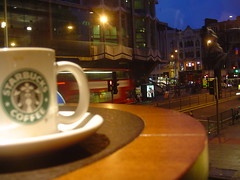
Over Christmas I reviewed some literature on locative media, and came across a handful of texts that addressed the changing role of the coffee house in our urban culture. Perhaps we are seeing a paradigm shift here: away from a BLVD-urbanism of public culture and towards a Starbucks Urbanism of a networked culture?
Kazys Varnelis and Anne Friedberg interesting essay Place: Networked Place starts with a descriptive ‘scene from Starbucks’. This is not your great-grandfather’s coffeehouse, found on a tree-lined European Boulevard with an outside terrace. It is no longer the coffeehouses that functioned as the proverbial meeting place or ‘public sphere’ where citizens irrespective of their background (as long as they wern’t women or other excluded groups that Habermas in his theory on the emerging public sphere overlooked) could engage in discussion with one another.
The café, and the rituals of coffee and caffeine that grew along with it, provided both forum and fuel for critical debate about the latest pamphlets, newsletters and broadsides. But the public sphere was not primarily a physical place, rather it was a discursive site where a literate public could conduct rational and critical debate. The assembly and dialogue that constituted this emerging public sphere occurred as much within the pages of newly circulated printed materials as it did within the walls of the coffeehouse.
In Starbucks people congregate not so much to communicate with one another. Rather they use it as a comfortable semi-public base from which they keep in touch with their personal friends or collegues through the 3 and 4-letter acronyms that make up our network society: GSM, SMS, UMTS, WIFI. As Marc Tuters writes in another key essay on locative media, this emerging Starbucks culture has often been described as antithetical to the public culture of the coffeehouses.
By contrast today’s ubiquitous Starbucks cappuccino bars offer the digital, mobile class a refuge from the pace of city, a space of introspection rather than random encounter. [these places] … form an archipelago of pseudo public spaces throughout the world’s cities. Particularly in the post-911 world, the function of these places to provide random encounter is practically eliminated in these insulted pay-access locations under the operative logic of ‘risk aversion’. Based on these observations, sociologists and urban theorists have developed a narrative of loss and decline in the contemporary literature on public space — Zukin (1991), Sorkin (1992), Hannigan (1998), in which contemporary public spaces are characterized theme parks, or walled gardens
Yet other more empirical research studies, such as Portable objects in three global cities: the personalization of urban places by Ito, Anderson and Okabe show that this binary opposition is too simplistic. In the article they describe a number of tactics through which people appropriate urban space. One of them is camping:
One brings a personal media device and works with it in a public space. Yet the goal is not to completely shut off public space, the public space is especially chosen because one finds it an agreeable location to work from. Like reading a paper in a café rather than at home. … They put down roots that have temporal limits, but are more extended than commuters who are simply passing through.
Camping is not so much about shutting out the environment: ‘people saw value in residing for a period of time in a desirable location. Just as people seek out beautiful campsites to set out there gear and reside for short periods of time, urbanites find attractive public places to temporarily set up camp with the help of their information technologies.’ For campers Starbucks is not a proverbial non-place, but a local place they engage with, where they perform their identity, yet at the same time keep in touch with absent others, still being part of their ‘full-time intimate communities’
Yet although one could argue that these Starbucks-like places – just like Habermas coffee houses – are not universal and neutral places but culturally coded and geared towards the neobohemian neoliberal bobo creative class (as vignettes, see this article and this one on ‘Coffee class war’) – I think Varnelis and Friedbergs conclusion is an interesting one, and much more insightful than just juxtaposing public coffeehouses with themed non-places:
We argue that culture is no longer localized in time and space, but neither is it non-place. Instead, individuals inhabit a physical world of simultaneous environments, of localized time and space as well as of multiple telematic worlds in which they can be co-present with others at a distance.
Yet, this still leaves some questions. To what extent are the sites of Starbucks-urbanism parochial rather than public spaces? And if they are mainly parochial, to what extend is that a threat to urban culture? Are critics clinging on to old, nostalgic ideas about a public culture? Or could new locative media ‘discovery’ services introduce new forms of contingency into Starbucks-urbanism?
